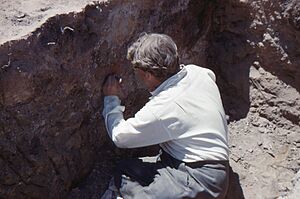James Mellaart facts for kids
James Mellaart (born November 14, 1925 – died July 29, 2012) was an English archaeologist and writer. He is famous for finding the ancient Neolithic town of Çatalhöyük in Turkey. However, he faced problems and was asked to leave Turkey because people thought he was involved in the illegal trade of old artifacts.
Mellaart was also part of several arguments, including one about a "mother goddess" in Anatolia. These issues eventually stopped him from digging at sites in Turkey in the 1960s. After he passed away, it was found that Mellaart had made up many of his "discoveries." This included fake murals and writings that he claimed helped him find the Çatalhöyük site.
Contents
About James Mellaart
James Mellaart was born in London in 1925. He taught at the University of Istanbul and was an assistant director at the British Institute of Archaeology at Ankara (BIAA). In 1951, Mellaart started leading digs at ancient sites in Turkey. His wife, Arlette, who was born in Turkey and worked as a secretary at BIAA, helped him.
He helped identify a special type of pottery from western Anatolia from the Late Bronze Age. This led to the discovery of Beycesultan in 1954. After that project finished in 1959, he helped share the results of their work. In 1964, he began teaching about the archaeology of Anatolia in Ankara.
Finding Çatalhöyük

In 1958, Mellaart and his team started digging at the Çatalhöyük site. They found over 150 rooms and buildings. Some of these were decorated with murals (wall paintings), plaster reliefs, and sculptures. This site became very important for understanding how some of the earliest and largest farming towns in the Near East worked. It helped people learn about their societies and cultures.
Mellaart believed that Çatalhöyük was a major place for worshipping a mother goddess. However, many other archaeologists disagreed with his idea. This disagreement caused a big argument. Mellaart was even accused of inventing some of the old stories he presented as real. Because of this argument, the Turkish government closed the site. Çatalhöyük was left untouched for 30 years until new digs started in the 1990s.
The whole ancient city covered about 32.5 acres (130,000 square meters). It was home to between 5,000 and 8,000 people. This was much larger than most towns of that time, which usually had only about a tenth of that many people. When Mellaart first announced the site, it caused great excitement. Later, it also caused a lot of confusion. However, newer research has found similar features at other early Neolithic sites in the Near East. This has helped many people better understand Çatalhöyük, and many of its old mysteries are now clearer.
The Dorak Mystery
In 1965, Mellaart told Seton Lloyd of the British Institute about a new, valuable discovery from Dorak. Mellaart claimed he saw these treasures in 1958 at the İzmir home of a young woman. He said he met her on a train because she wore a gold bracelet that caught his eye. She told him she had more treasures at home, so he visited her. He saw the collection but was not allowed to take photos. However, she let him make drawings of the items.
Mellaart shared this story with The Illustrated London News. Turkish officials then wanted to know why they hadn't been told about such an important find. Mellaart said the young woman, named Anna Papastrati, asked him to keep it a secret. He asked the British Institute to help publish the story, but they refused because there was no real proof. When people looked for Papastrati's home, it turned out the address didn't exist in İzmir. Her name also couldn't be found. The only document linked to her was a typed letter that seemed to have been written by Mellaart's wife, Arlette. Because of this, Turkish officials suspected Mellaart of illegally moving ancient items and made him leave the country. He was later allowed to return but was eventually banned completely from working there.
Later Life
By 2005, Mellaart had stopped teaching. He lived in North London with his wife and grandson. He passed away on July 29, 2012.
Ideas About Ancient Anatolia
Mellaart had ideas about the earliest Indo-Europeans in northwest Anatolia. He believed they were horse riders who came from the north. He thought they founded Demircihöyük in Eskişehir Province, Turkey, around 3000 BCE. He suggested they were the ancestors of the Luwians, who lived in Troy II and spread across the Anatolian peninsula. Mellaart was the first to use the term "Luwian" in archaeology in the 1950s. Today, many studies and digs support some of Mellaart’s ideas about changes in ancient cultures in that area.
Mellaart pointed to a new type of pottery, called Red Slip Wares, as proof for his ideas. He thought that the early Luwian people moved to Anatolia in several groups over many centuries. Today, experts often believe these movements were mostly peaceful, not military takeovers. Mellaart focused on events where cities like Troy II (around 2600–2400 BCE) were destroyed. He linked these events to the arrival of Indo-Europeans from the eastern Balkans.
Fake Discoveries
In 2018, Mellaart's son Alan and a scientist named Eberhard Zangger published a study. They found that Mellaart had created many fake items to support his ideas. After looking through Mellaart's apartment after his death, Zangger found that Mellaart "faked several of the ancient murals." He suggested Mellaart might have even had a "forger's workshop." These fake items included early versions of murals and carvings that Mellaart had claimed to find at Çatalhöyük.
The Beyköy 2 Writing
Another text Mellaart presented was a Hieroglyphic Luwian writing called Beyköy 2. This text made big news in 2017 because it claimed to tell the history of groups known as the Sea Peoples (to the Egyptians) and the Philistines (in the Bible). However, this text might also be a fake. Several experts have argued about whether it is real.
Zangger and Fred Woudhuizen, who shared the text after finding drawings of it among Mellaart's papers, believe it is real. They think the drawings were copies of older drawings made in 1878. But other experts think the writing is fake. They point out that it looks like Mellaart's other fake items and doesn't fit what is already known about that time in history.
Works by James Mellaart
- "Anatolian Chronology in the Early and Middle Bronze Age"; Anatolian Studies VII, 1957
- "Early Cultures of the South Anatolian Plateau. The Late Chalcolithic and Early Bronze Ages in the Konya Plain"; Anatolian Studies XIII, 1963
- Çatal Höyük, A Neolithic Town in Anatolia, London, 1967
- Excavatians at Hacilar, vols. I–II, Edinburgh, 1970
- The Neolithic of the Near East, New York, 1975
- The Goddess from Anatolia, 1989 (with Udo Hirsch and Belkıs Balpınar)
See also
- Matriarchy
- Potnia Theron
- Religion in prehistory
- Slow Train to Izmir
- Venus figurines
- Middle Bronze Age migrations (ancient Near East)
- Archaeological forgery


